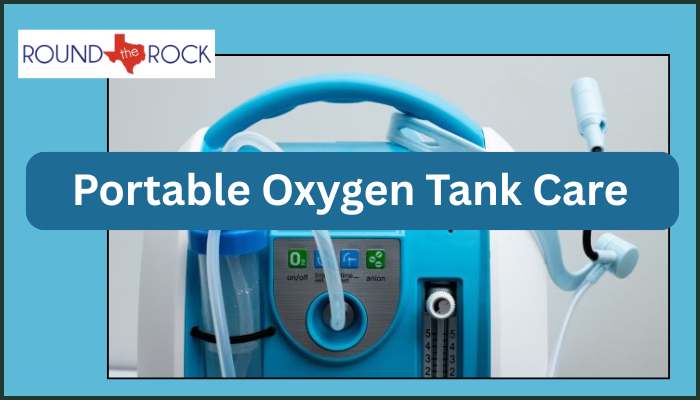Portable Oxygen Tank Care: Maintenance Tips for Beginners
Learn how to maintain your portable oxygen tank with our simple daily, weekly, and monthly maintenance tips for beginners. Keep your unit safe and reliable.

A portable oxygen tank is a lifeline for many people, providing the freedom and mobility to live life more fully. To keep it functioning correctly and safely, regular maintenance is necessary.
Proper care keeps your equipment in top condition and gives you peace of mind, knowing your oxygen supply is reliable whenever you need it.
This guide provides a straightforward portable oxygen tank maintenance schedule for beginners. We will cover daily, weekly, and monthly tasks, along with safety precautions and troubleshooting advice. Following these simple steps will help you manage your portable oxygen tank with confidence and effectiveness.
Understanding Your Portable Oxygen Tank
Before you can properly maintain your portable oxygen tank, it is essential to understand its components. The main cylinder holds the compressed oxygen. The regulator is a crucial device that attaches to the top of the tank. It controls the pressure of the oxygen as it flows out and allows you to adjust the flow rate to your prescribed level. The conserver is a device that helps save oxygen by delivering it only when you inhale.
Connected to the regulator is the tubing, often a nasal cannula or a mask, which delivers the oxygen to you. The carrying case protects the tank from damage and makes it easier to transport. Each component plays a vital role in the system’s overall function. A problem with any one part can affect the entire system’s performance and your safety. Regular checks on all these components will keep your unit working as it should.
Daily Maintenance Practices
You should incorporate a few simple tasks into your daily routine to keep your portable oxygen tank in excellent working order.
First, clean the exterior of the tank and the carrying case. Use a damp cloth to wipe away any dust or dirt that may have accumulated. Avoid using harsh chemicals or abrasive cleaners that could damage the surfaces. Clean the nasal cannula or mask according to the manufacturer’s instructions, typically with warm, soapy water, then rinse and air dry it completely.
Next, perform a visual inspection of the entire unit. Look for any signs of damage, like dents or scratches on the tank itself. Check the tubing for cracks, kinks, or discoloration. A damaged tube can restrict oxygen flow or cause a leak.
You should also check for audible leaks. Listen for any hissing sounds coming from the connections, as this could indicate that oxygen is escaping.
Proper storage is also part of your daily care. When you are not using the tank, store it in an upright position in a well-ventilated area. Keep it away from heat sources, open flames, and flammable materials. Do not store it in a closet or a car trunk where temperatures can rise. Following these daily steps will help maintain the system’s integrity and safety.
Weekly Maintenance Practices
Once a week, you should perform a more thorough inspection of your equipment. Focus on the regulator and its connections. Check that the regulator is securely attached to the tank. A loose connection can cause leaks and affect the accuracy of the oxygen flow. Examine the O-ring or gasket that seals the connection between the tank and the regulator for any signs of wear or damage. If it looks worn, you should replace it immediately.
Use this time to verify the oxygen level and flow rate. Check the pressure gauge on the regulator to determine the remaining oxygen level in the tank. This investigation helps you plan for refills and avoid running out unexpectedly. Set your prescribed flow rate and listen to the flow of oxygen through the cannula. Place the tips of the cannula in a glass of water to see bubbles, which confirms that oxygen is flowing correctly. Regular verification gives you confidence that you are receiving the correct amount of oxygen.
Monthly Maintenance Practices
Monthly maintenance involves more detailed checks and sometimes requires professional assistance. Schedule a professional inspection and servicing for your portable oxygen tank at least once a year, or more frequently if recommended by your supplier. A qualified technician can perform tests that you cannot, such as checking for internal corrosion and verifying the regulator’s accuracy.
You should also use this time to replace any worn-out parts. Depending on your usage, you may need to replace parts like the nasal cannula and tubing monthly to maintain hygiene and functionality. Keep a stock of spare parts, including O-rings and filters, so you can replace them as needed.
Reviewing the features you want in a portable oxygen tank unit can help you decide if your current model still meets your needs or if an upgrade with more advanced, lower-maintenance components is a better option. Regular professional servicing and timely part replacement are critical for the long-term performance of your equipment.
Common Issues and Troubleshooting
Even with diligent maintenance, you might encounter some common issues. Leaks are a frequent problem and often occur due to a faulty O-ring or a loose connection. If you hear a hissing sound, you can apply a soapy water solution to the connections. Bubbles will form at the site of the leak. Tighten the connection or replace the O-ring to fix it.
Pressure problems can also occur. If the pressure gauge shows a sudden drop, it might indicate a significant leak or a faulty regulator. In this case, stop using the tank and contact your supplier for assistance. Irregularities in the flow rate can happen due to a kink in the tubing or a blockage in the cannula. Straighten any kinks and clean the cannula to resolve the issue. If the problem persists, the regulator may need to be serviced by a professional.
Safety Precautions
Handling oxygen tanks requires strict adherence to safety rules. Oxygen is not flammable itself, but it can cause other materials to ignite more easily and burn more intensely. Never smoke or allow open flames near an oxygen tank. This open flame includes candles, gas stoves, and fireplaces. Keep the tank at least five feet away from any heat source.
When using oxygen, avoid using oil-based products, such as petroleum jelly, on your face or hands, as these can be flammable in an oxygen-rich environment. Use water-based lubricants instead. Always handle the tank with care and avoid dropping it. When traveling, secure the tank to prevent it from tipping over or rolling around. These precautions protect you and those around you from potential hazards.
Ready To Breathe Easier?
Regular maintenance is the key to keeping your portable oxygen tank safe, reliable, and effective. By following a simple schedule of daily, weekly, and monthly checks, you can prevent common problems and extend the life of your equipment. Understanding each component and its function empowers you to take control of your care.
Consistently cleaning your equipment, checking for damage, and verifying its performance will give you the confidence to lead an active and independent life. Remember that your oxygen provider is a valuable resource for professional servicing and advice. Taking these steps helps protect your investment and, more importantly, your health and safety.





